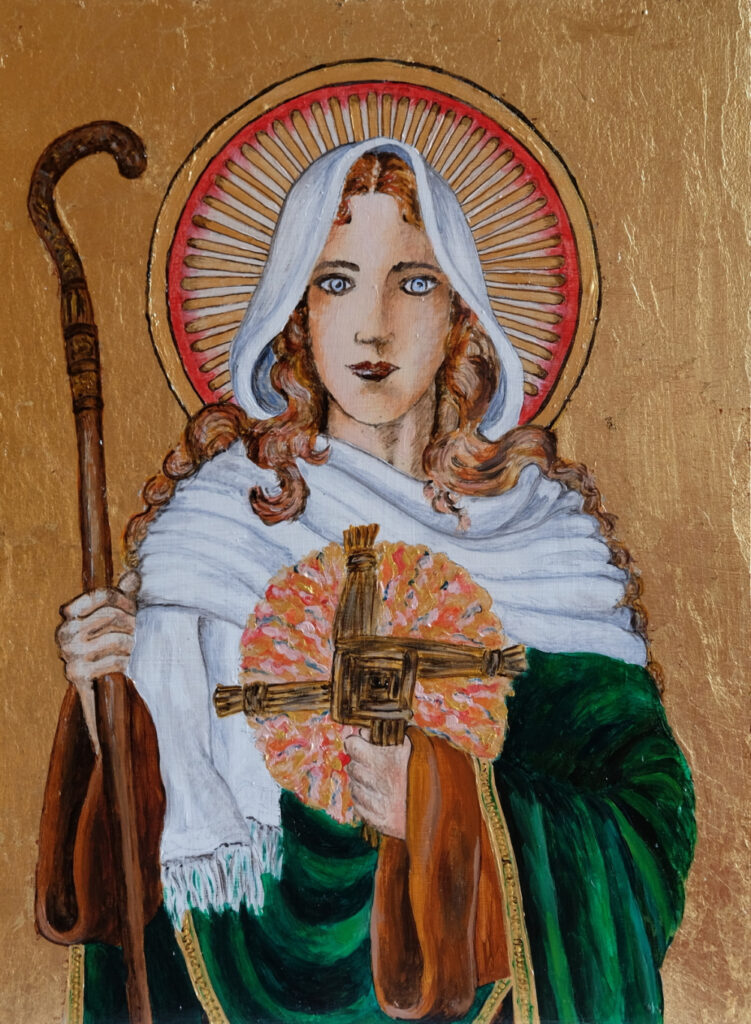
Saint Brigid of Kildare
In celebration of St. Patrick’s Day, we are dedicating the month to looking at Irish saints. Aside from Patrick, few know the others. Here is your chance to learn.
St. Brigid knew St. Patrick. As a matter of fact, her mother was converted from paganism by that loved saint. Brigid’s mother was Brocca. She was a slave of the pagan chieftan, Dubthach who lived in Fochart, County Louth, Ireland. As happens with slaves, Brocca became pregnant by her owner. The wife of the owner was not pleased to hear that news, so she sold the slave to a Druid landowner. Tradition tells us that Brocca couldn’t nurse Brigid. But all the milk and food given to the baby only made her vomit. The reason implied was that the Druid was impure. Only a white cow with red ears could satisfactorily feed the baby.
The child grew to be very charitable, giving away anything to poor people and healing them.
When she was ten, and of an age to leave her mother, she was sent back to Dubthach, since she was his legal slave. She continued her extreme charity, giving away anything belonging to her master/father. Dubthach eventually took her to the king, intending to sell her. While there, Brigid took his jeweled sword and gave it to a begger to exchange for food. The king, a Christian himself, noticed and saw her heart. He convinced Dubthach to give Brigid her freedom, saying, “Her merit before God is greater than ours.”
Brigid, by now in her teens, returned to her mother and the Druid where she helped her mother run the dairy. Despite the fact that Brigid seemed to give away much milk, the dairy prospered. Probably in thanksgiving, the Druid gave Brocca her freedom.
Several years had passed and Brigid returned to her father’s home. He wanted to marry her off. She, having taken a vow of chastity, refused. She even prayed that her beauty be taken away so that no one would wish to marry her. She lost an eye. By her late teens, she was consecrated a virgin. It is said that St. Patrick may have attended. Her eye was miraculously returned to normal.
But it was almost twenty years before the king of Leister donated land for her to establish a monastery with enough land for sheep and cows to graze. The monastery was established under an old oak tree where the shrine of a pagan goddess lay. Hence the name Cill Dara, “church of the oak”, or Kildare. Over the years, two monasteries, one for men and one for women, were established. A hermit, Conleth, was invited to be the spiritual advisor, to govern the church along with herself. Later, they founded a school of art that included metalwork and illustration. The Book of Kildare was produced at that time. Later pilgrims were sure the book was the work of angels since it was so finely drawn.
Brigid’s life is full of miracles. The book’s production is one instance. Her charitable works included blessing apple orchards to double protection and turning water into beer. She was buried at the church in Kildare but her remains were rescued and hidden during Scandinavian raids. Her relics are now scattered throughout Europe.
Brigid is the patron saint of dairy workers, brewers, children of abusive parents, among others.

Recent Comments